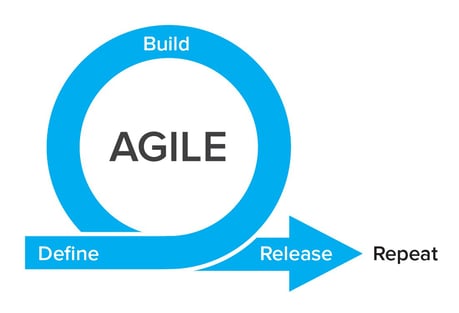At the end of the 1990s, Dave Thomas and about a dozen other software developers met at a ski resort in Utah, and ended up changing software development forever. In their Manifesto for Agile Software Development, the group laid out a flexible, simple and clear approach to software development that has now been adopted by many other industries. Instead of working linearly on one enormous multi-year master plan of development, the group recommended working in fast, repeatable cycles called “sprints” to allow for more flexibility and a faster pace of product development.
 When applied to marketing, the Agile approach focuses on producing and evaluating marketing efforts on this same sprint basis, so that high value projects can be identified and intensified, while lower value efforts can be used as learning. Agile marketing means better results, because we can quickly assess what’s working and pivot to put resources where we expect the best outcomes.
When applied to marketing, the Agile approach focuses on producing and evaluating marketing efforts on this same sprint basis, so that high value projects can be identified and intensified, while lower value efforts can be used as learning. Agile marketing means better results, because we can quickly assess what’s working and pivot to put resources where we expect the best outcomes.
What is Agile Project Management?
The original Manifesto for Agile Software Development aimed for simplicity and clarity, and built in more feedback along the way. Traditionally, project management teams will have a scrum master, their scrum team, and a product owner, all of whom work on two-week sprints. The methodology is rooted in collaborative, small batch work with the goal of achieving small wins like feature additions, or speed improvements. It allows developers to respond to change, rather than being locked into a plan, which was the tradition for software development up until Agile came along. In the pre-Agile world, we’d typically see only 1-2 updates to a software release over the course of a year. On development teams that use Agile, apps, SaaS and software are in a constant state of iteration and improvement.
How Do Marketers Use Agile?
Agile project management isn’t just for software development. An Agile approach is perfect for marketers, because it encourages shorter bursts of work with analysis in between. That means evaluating the performance of nearly everything we do on an ongoing basis and making pivots in real time for better marketing outcomes.
Just as in software development, Agile marketers work in sprints. For us, sprints tend to be monthly, because of the nature of most marketing tactics and tasks. For example, consistent publishing of well-planned blog content takes time and effort for topic planning, research, copywriting, editing, approvals and publishing. Rather than focusing an entire month on one marketing campaign, tactic, or project, however, several initiatives will be pushed forward incrementally at the same time.
Of course, there is a strategy to guide and cohere the efforts, based on best practices, former results, and marketing knowledge, but execution and analysis are where the sprint methodology shines. That’s because if something isn’t working, we can quickly stop, and when something is a success, we can put more resources into that effort. Agile marketing means better marketing results overall, and encourages data analysis over rigid cohesion to a predetermined plan.
A Month in the Life of an Agile Marketer
A typical month of planning for an ongoing digital marketing retainer includes the next phase or task for each of a series of main work categories, as well as evaluation of ongoing efforts for potential pivots, and planning for the next month. Here at ClearPivot, our Account Strategists normally push efforts forward on a number of concurrent fronts, all working toward one or more main strategic goals for the client.
Here at ClearPivot, monthly task areas typically include:
- Case study production
- Lead nurturing workflow production
- Search engine advertising management
- New website content (copy, design and development)
- Ongoing improvement of existing website content
- Visual design
- Email campaigns
- Social media (organic)
- Social media (paid)
- Reporting and evaluation
Operating in sprints, and working incrementally on several different projects at a time, allows us to push the marketing mission forward on several fronts at once. Especially in the context of digital immediacy, marketers must be quick to create, quick to evaluate and quick to change when change is needed. Using categories of tasks helps us to keep the rapid pace of task planning corralled into a manageable plan for each sprint.
Agile Marketing Allows for Continuous, Incremental Improvement
Using an Agile project management methodology allows for continuous improvement of marketing programs, because we can do more of what works and cut more of what doesn’t on an ongoing, nearly real-time basis. The availability of real time data is one crucial component that makes this shift possible, because we can now see the results of a digital advertising campaign, premium content offer, or lead generation effort immediately. Using reporting from systems like HubSpot, Google Analytics and Databox allows marketers to actually become agile. We can launch a new campaign, or implement a new tactic for a specific audience, and see the results within a matter of days. Using that data, we can analyze what is going right and do more of it. And, that ends up resulting in better outcomes for lead generation, lead nurturing, and eventually, the bottom line.
